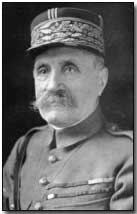Primary Documents - British Eyewitness Report of Armistice Negotiations, 8 November 1918
 With German military morale
in evident decline on the Western Front and revolution brewing at home -
Kaiser
Wilhelm II was himself obliged to abdicate on 9 November 1918 -
the German government determined to
negotiate an armistice with the Allies
on 6 November, having issued preliminary diplomatic feelers two days
earlier.
With German military morale
in evident decline on the Western Front and revolution brewing at home -
Kaiser
Wilhelm II was himself obliged to abdicate on 9 November 1918 -
the German government determined to
negotiate an armistice with the Allies
on 6 November, having issued preliminary diplomatic feelers two days
earlier.
Consequently on 7 November the German Army Chief of Staff Paul von Hindenburg exchanged a series of telegrams with the Supreme Allied Commander, Ferdinand Foch, to agree a date, time and place for formal negotiations. (Click here to read another Allied eyewitness account of the armistice negotiations; click here to read an account by a German delegate.)
Although Germany had insisted that it would only enter into negotiations on the understanding that U.S. President Woodrow Wilson's so-called 'Fourteen Points' would form the basis for a settlement, the armistice terms were nevertheless punitive. The Allies agreed to an armistice only on the basis that Germany effectively disarm herself, thereby preventing the latter from renewing hostilities.
The Allies' armistice terms were presented to German negotiators on 8 November 1918; alarmed at the severity of the terms the Germans lodged formal protests before reluctantly signing at 5 a.m. on 11 November; the armistice was to come into effect six hours later, at 11 a.m.
President Wilson shortly afterwards announced details of the armistice to Congress, and further celebrated the agreement in a Thanksgiving Address at the close of the month.
British Eyewitness Report of Armistice Negotiations, 8 November 1918
The roads were a mass of mud, motor-cars of all sorts were ranged by the side of the main street, and the German plenipotentiaries were temporarily halted because of a breakdown to a motor lorry in the road in front of them.
There were seven cars in all, two of them belonging to French Headquarters and five being German. The plenipotentiaries must have halted for nearly half an hour, and certain members of the junior staff attached to them got down while the details of a fresh route to be followed were discussed by them with the French officers by whom they were being escorted.
The senior members remained in the cars, invisible in darkness. Those we saw were of the typical officer class, clean-shaven and almost aggressively self-contained. For the most part they were silent, but occasionally they talked in low tones.
On the pavement by the houses there was a continual movement of French soldiers. No guard was round the cars, for any sort of guard was entirely unnecessary.
There was not a single individual among the two or three hundred men present who even moved forward to catch a glimpse of the mission. There was no question as to any one doubting their identity, for the cars bore on their panels the crest of the Black Eagle.
The demeanour of the French soldier was typical of the high standard of courtesy set by Marshal Foch. Both army and nation realized that with Marshal Foch in command the terms of the armistice were in absolutely safe hands, as he had abundantly shown that he had taken to the full such measures as the situation required.
He insisted, however, that every detail of the transaction should be conducted in absolute privacy, and there was not present at the historic meeting a single representative of the French or allied press.
Source: Source Records of the Great War, Vol. VI, ed. Charles F. Horne, National Alumni 1923
'minnie' was a term used to describe the German trench mortar minnenwerfer (another such term was Moaning Minnie).
- Did you know?
